principles of pest & disease management
Goals of the Home Orchard vs. Commercial Orchards
Fruit trees have been grown in home orchards for centuries. The goal of many gardeners today is to have fresh fruit from their own trees with a minimum of spraying. There are many ways to reach that goal, but we feel young fruit trees do need some annual spraying to be healthy and productive. We try to emphasize organic and least toxic methods for keeping your orchard healthy. Your goal is to have healthy trees the produce enough high quality fruit to satisfy your needs. Your home grown fruit does not have to be cosmetically perfect. A commercial grower has to produce good looking marketable fruit at low enough cost to be economically viable.
When starting your home orchard, make sure you:
Choose disease resistant fruit tree varieties when possible.
Monitoring your orchard for bud and blossom stages is the key to good dormant spray (proactive) timing.
Monitoring your orchard for problems as they arise is key to good pest management.
Know why you are spraying! Some sprays recommended here are proactive- trying to prevent common problems through maintenance. Beyond general maintenance (dormant) spraying, never spray without identifying the problem.
When mixing spray solutions, always mix less than you think you will need, as disposal of the leftovers is difficult. Try spraying just water on your orchard to see how much will give you good coverage.
Always follow the directions on the container label. If the label is missing or unreadable, contact the company for directions (most pesticide labels are available online).
Many insect pests have natural controls in the form of beneficial insects. Avoid using broad spectrum insecticides if possible. If they are necessary, spray at dawn or dusk to limit the impact on bees and other beneficial insects.
Links throughout the page take you to two valuable information sites:
PNW Pest Management Handbook, an important pest and disease management web page that is focused on the Pacific Northwest. This is a joint effort of agricultural extension scientists from Oregon State University, Washington State University, and the University of Idaho. Used mostly by commercial growers, it has a wealth of information on life cycles of pests and diseases, and both conventional and organic treatments.
WSU Extension Hortsense, which is a home gardener focused compilation of fact sheets for managing common landscape and garden plant problems.
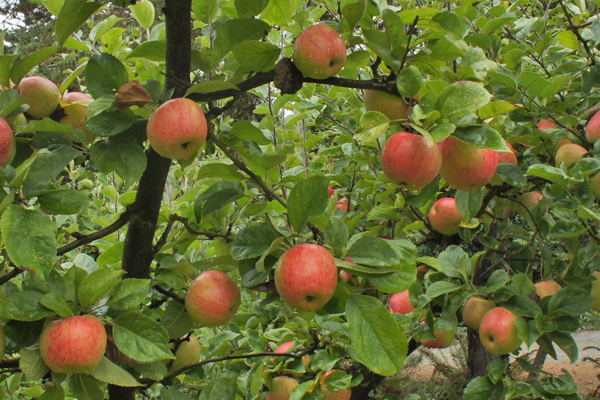
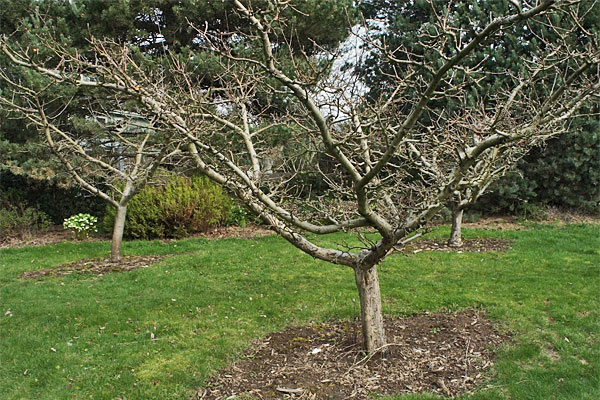
Tree Fruit Crops for Western Washington and common issues
The most serious issues in growing tree fruits in our climate are fungal and bacterial diseases. Our climate challenges us first by its inconsistent seasonality (possibility of warm or cold winters changing when trees break dormancy). Our second challenge comes from our cool, rainy springs, which encourages fungal diseases that affect blossoms and developing fruit.
Insect pests can also be a challenge in the home orchard. Some homeowners might be tempted to ignore pest issues, but allowing pest populations to increase may cause problems for your neighbors, so knowing how and when to react is important.
-
- Fungal diseases including scab and powdery mildew
- Bacterial canker disease, including anthracnose
- Insect pests, including leaf roller, apple maggot and codling moth
Pears
-
- Fungal diseases including pear scab and pear trellis rust
- Bacterial dieback disease caused by pseudomonas(Asian pears)
- Insect pests including blister mite and occasionally codling moth
Cherries, sweet or sour
-
- Bacterial canker diseases
- Fungal diseases including brown rot.
- Insect pests including spotted wing drosophila
Peaches & Nectarines
-
- Fungal diseases including peach leaf curl and brown rot
- Bacterial cankers
Plums
-
- Fungal diseases including brown rot and black knot
- Aphids
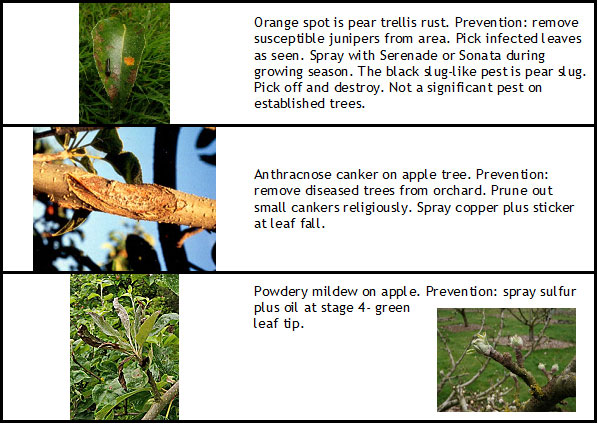
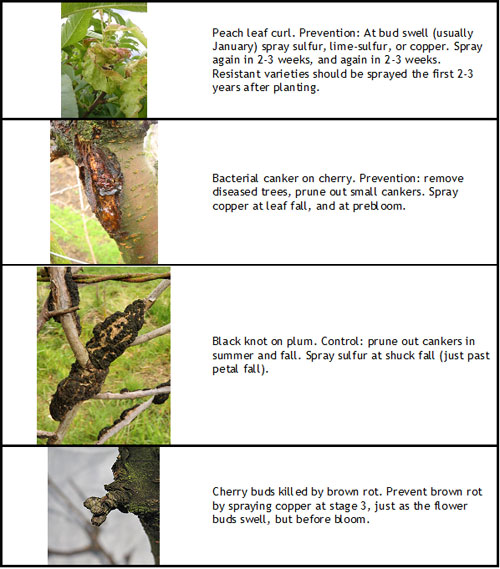
Management Strategies, or how do you keep your trees healthy?
Fruit trees as we know them today have gone through centuries of selection. Because they were developed for fruit quality and production, many of their natural resistances to pest and diseases have been lost.
The home orchardist has the goal of keeping their trees healthy and productive. Because of the challenges of our climate, you will need to do some sprays, especially on young trees. You can grow healthy trees using organic methods, but to be successful, you need to be proactive. Organic disease control needs to be in place before the infection occurs.
Especially for young trees, repeated ‘misses’ on your timing can lead to stunted trees and blind wood (no fruit buds). Learning to use bud stages and heat units to time your controls is important, especially when using organic sprays. Online decision making tools/websites are very valuable in helping you target your strategies:USPest.org – this site uses weather stations to run disease and pest models and help you make decisions on when to spray. It is worth spending time here, learning to use the models. It will let you set up the models that work for your orchard, using the weather stations closest to you. We have a tutorial on using this valuable tool that walks you through the set up. For most home orchards, look at the models for:
-
- Apple Scab
- Pear Scab
- Codling Moth
- Apple Maggot
Ag Weather Net – this site is run by WSU, and uses just the Ag Weather stations throughout WA state. It requires registration to use, and many of the models require a subscription. For some homeowners, there will not be a weather station close enough to you to make this site useful (weather stations are only located in prime agricultural land areas).
When planting new trees, try to choose disease resistant varieties. Look for scab and mildew resistance in apples and pears, and leaf curl resistance in peaches. Later blooming sweet cherries and all tart cherries are easier to grow in frost prone sites.
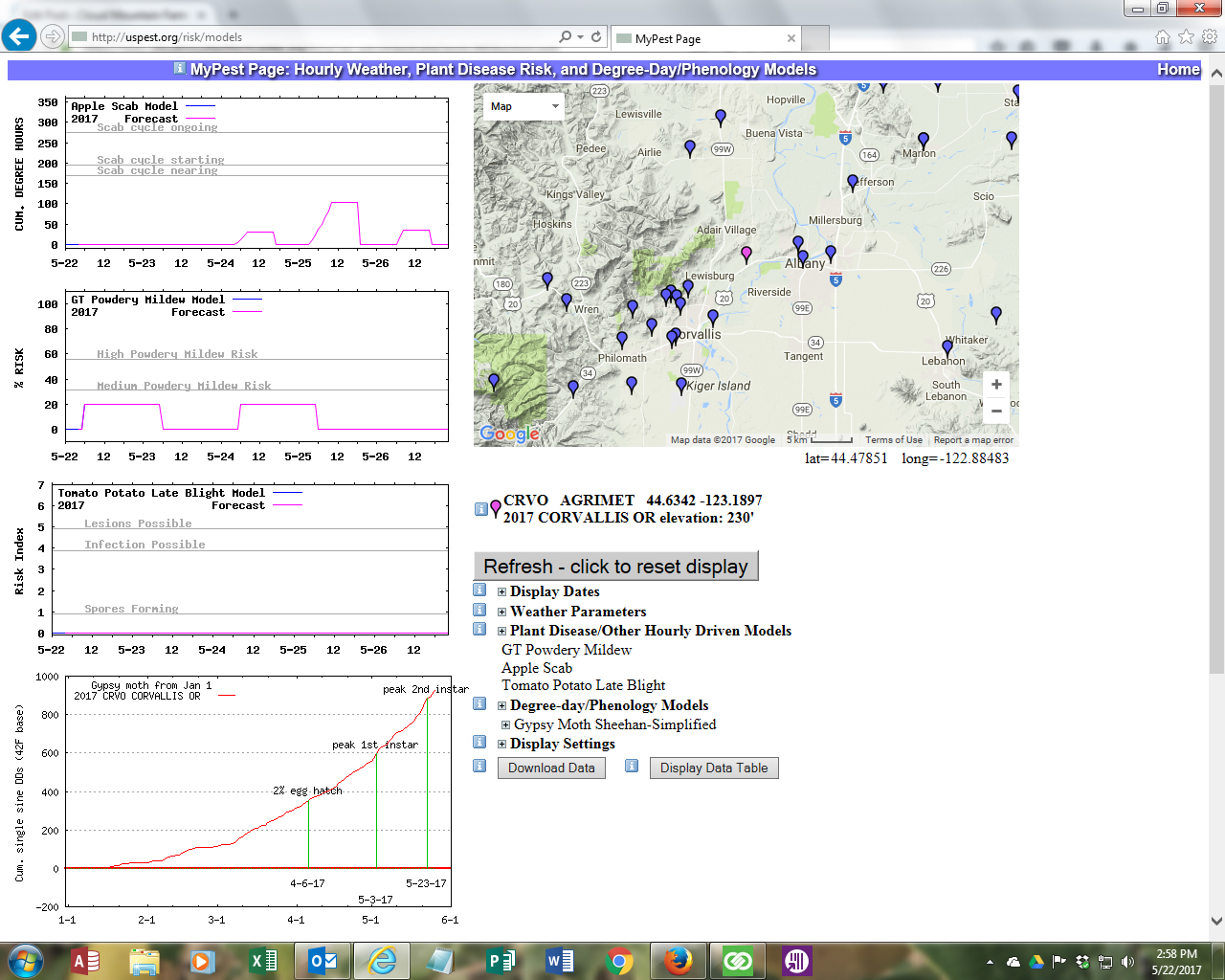
Organic Products for Fungal and Bacterial disease control
Micronized Sulfur– available as powder and occasionally liquid concentrate form.
-
- Use with oil for delayed dormant sprays on pears and apples, controls powdery mildew, between stages 4 and 6
- Use for scab control on apples and pears, at pre-pink and petal fall
- Use with oil at leaf fall to control blister mite on pears
- Use at shuck fall (just after petal fall) on plums to help control black knot
Copper, as copper sulfate or copper soap
-
- Use at stage 3, combined with oil, on cherries, peaches and apricots, to control blossom blight and brown rot. The oil will smother overwintering aphid and mite eggs
- Use with a sticker at leaf fall on stone fruits to protect against bacterial canker, and on pome fruits to protect against anthracnose and pseudomonas canker.
Serenade/Sonata and Monterey Complete Disease Control– bacterial based fungicides that provides some control against fungal diseases, and unlike copper, can be used on actively growing trees.
-
- Powdery mildew on pome fruits
- Brown rot on stone fruits
- Pear blister rust (not complete control, some suppression)
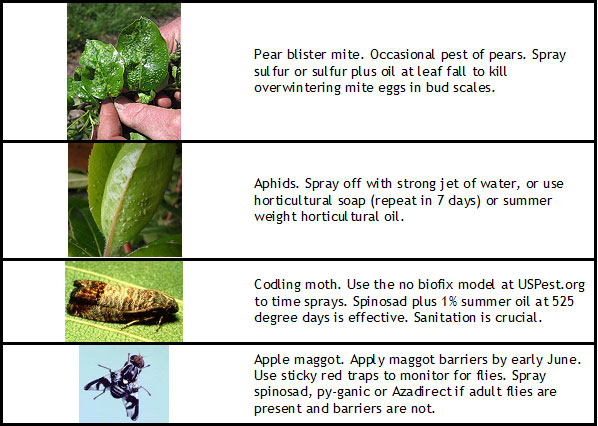
Organic Products for Pest Control
Horticultural oils, either mineral or vegetable based, are effective at smothering overwintering eggs of aphids and mites. They need full contact/coverage to work, and if used during the growing season can cause foliage and/or flower burn on some varieties
Horticultural soap is used to control soft bodied insects such as aphids during the growing season. They need repeat applications to work.
Bacillius thuringiensis (Bt) is a bacterial control for the larval stages of many moths. The main use in the home orchard is to control leaf roller on apples and pears. Add this to your delayed dormant and first scab sprays to get the early hatch. This product can also be used for the early stages of webworm outbreaks.
Spinosad is also bacteria based, but broader spectrum. It is toxic to bees, so do not use it when bees are active. It is effective on codling moth, and somewhat effective on apple maggot. There is a danger of overuse, leading to resistant pests, so should be used with caution.
Codling Moth virus (Cyd-X, Carpovirusine, Virosoft) is a virus based control for codling moth only. Timing is crucial, and it is an expensive product.
PyGanic is formulated on an extract of the daisy Pyrethrum, creating a powerful broad spectrum insecticide. It is very toxic to bees and other beneficial insects as well as pest insects, so should be used with caution.
Mycotrol is a fungal based insecticide that is effective against aphids and leaf hoppers. Expensive and hard to find locally.
Neem oil based insecticides, including Azadirect are effective on some insects including SWD, pear slug, apple maggot, and cherry fruit fly.
Kaolin clay can “hide” the tree and fruit from insect pests, by coating the leaves and developing fruit with a material that is irritating to the flies and moths. This product is most commonly used to control Apple Maggot. It needs to be reapplied often to be effective.
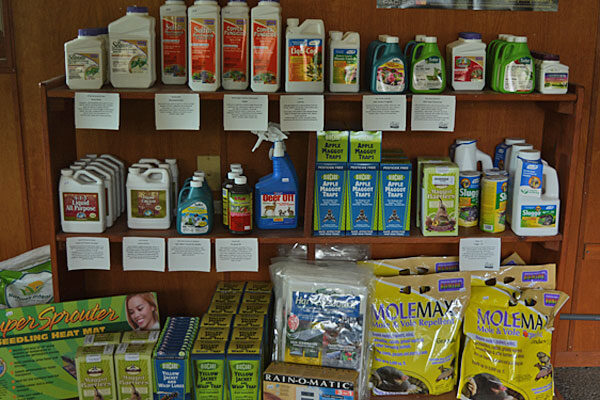
Using bud stages to time sprays
Observing the bud development stages of fruit trees from dormant to full bloom is the key to proactive disease and pest management. Timing your sprays to bud stage allows you to spray less and get better control. Following the bud stage chart, we have suggestions for specific timings of disease controls. Most organic disease control sprays are prophylactic- the spray must be on the tree before the fungal or bacterial infections occur.
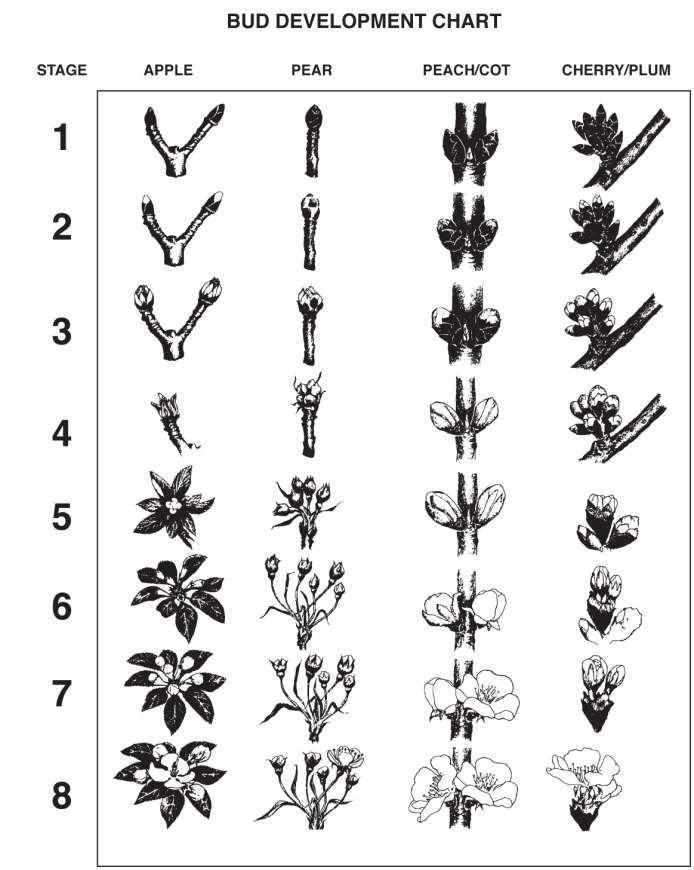
annual orchard calendar
All Year
- Prune your trees to keep them open to light and air circulation
- Keep the orchard clean, removing diseased wood, foliage, or fruit when present. Rake up fallen leaves in the fall, or mow them so they decay quickly.
- Keep the trees adequately watered in summer. Stressed trees are more prone to problems.
- Encourage your neighbors to keep their fruit trees healthy, too. Pests don’t recognize your property boundaries
Winter
Apples and Pears
Bud stage 1 (dormant bud): Apply dormant oil, being sure to thoroughly coat the branches and trunk bark, to help control codling moth. This spray is only recommended if you have had codling moth in your fruit.
Peaches
At bud break or stage 2 (see Bud Development Chart), apply copper sulfate to protect for Peach Leaf Curl. Spray every 3 weeks for a nine-week period (3 sprays) or until the tree is leafed out. Resistant varieties like Frost Peach develop resistance but should be sprayed until established.
Pears (plantings less than 2 years old)
When first green shows in buds, apply copper sulfate or fixed copper, or copper soap to prevent pseudomonas (bacterial dieback) infection. Asian pears are most susceptible.
Spring
Apples and Pears
Between stages 4-6 apply a delayed dormant spray of micronized sulfur and horticultural oil. This spray helps protect the trees against powdery mildew infections and smothers eggs and crawlers of aphids, mites, leafrollers, and scale insects.
Between stages 6-7 apply a spray of micronized sulfur (no oil) to prevent apple scab, pear scab, and powdery mildew. This spray is not necessary for varieties resistant to these diseases. Bacillus thuringiensis (Bt.) can be added to this spray to help control leafroller. Bt. can also be applied separately or mixed with insecticidal soap to control leafrollers and cutworm at this time.
At petal fall apply a second scab and mildew spray, using micronized sulfur (no oil). Bacillus thuringiensis (Bt.) can be added to this spray to help control leafroller. Bt. can also be applied separately or mixed with insecticidal soap to control leafrollers and cutworms at this time.
Apricots
At stage 3 apply a delayed dormant spray of copper mixed with horticultural oil. Copper is somewhat effective against blossom blight and brown rot, and the oil will smother eggs and crawlers of overwintering pests. Never use sulfur on apricots as it can burn the foliage.
Peaches, Cherries, and Plums
At stage 3 apply a delayed dormant spray of sulfur mixed with horticultural oil. Sulfur is effective against blossom blight and brown rot, and the oil will smother eggs and crawlers of overwintering pests.
Plums
If black knot has been observed, prune out affected branches 2-3 inches below the knot.
Summer
All Fruit Trees
Monitor foliage for aphids, leafrollers, cutworms and other insect pests. Spray if damage is apparent. Insecticidal soap or summer oil are effective on aphids. Bt. is effective on caterpillars and leafrollers, and most effective sprayed late afternoon or on cloudy days.
Apples, Pears
Monitor and control codling moth and apple maggot- details to follow. Remove fruit with obvious stings (entry holes) and destroy.
Pears and Cherries
Monitor for pear slug (actually a sawfly larvae). Hand pick small numbers. Spray larger infestations with insecticidal soap, neem oil, or dust with diatomaceous earth. Monitor for pear trellis rust on pear trees- pick and destroy leaves with orange spotting. If possible remove junipers from area (alternate host for pear trellis rust).
Plums
Monitor for black knot infections, and prune below the knots after harvest.
Fall
Pears
If blister mite has been observed, spray lime-sulfur (Calcium polysulfide), micronized sulfur or sulfur plus horticultural oil just after leaf drop, thoroughly covering all buds and bark. Spray again in spring at bud break.
All Fruit
Rake up and destroy fallen leaves and fruit. If codling moth or apple maggot has been a problem, do not compost but discard the fruit. Fruit trees prefer a soil pH of 6.8-7. At this pH, the trees can make use of the nutrients available in the soil. Our native soils typically are 5.5 or below- acidic. If a pH test of your soil shows acid conditions, apply lime in the fall. In addition to raising the soil pH, lime will supply calcium to the trees, important for good fruit quality, and also help fallen foliage decay. Some studies show liming in the fall can lessen scab spores the following spring.
